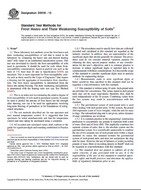Potřebujeme váš souhlas k využití jednotlivých dat, aby se vám mimo jiné mohly ukazovat informace týkající se vašich zájmů. Souhlas udělíte kliknutím na tlačítko „OK“.
ASTM D5918-13
Standard Test Methods for Frost Heave and Thaw Weakening Susceptibility of Soils
Automaticky přeložený název:
Standardní zkušební metody pro Frost zvedat a obleva oslabení náchylnosti půd
NORMA vydána dne 1.2.2013
Informace o normě:
Označení normy: ASTM D5918-13
Poznámka: NEPLATNÁ
Datum vydání normy: 1.2.2013
Kód zboží: NS-33072
Počet stran: 13
Přibližná hmotnost: 39 g (0.09 liber)
Země: Americká technická norma
Kategorie: Technické normy ASTM
Kategorie - podobné normy:
Anotace textu normy ASTM D5918-13 :
Keywords:
freeze-thaw test, frost susceptibility, roads and runways, soil and aggregate, thaw weakening susceptibility, ICS Number Code 13.080.01 (Soil quality in general)
Doplňující informace
| Significance and Use | ||||||||||||||||||||||||||||||||||
|
5.1 These test methods can be used to determine the relative frost-susceptibility of soils used in pavement systems. Both the frost heave susceptibility and the thaw weakening susceptibility can be determined. 5.2 These test methods should be used only for seasonal frost conditions and not for permanent or long-term freezing of soil. These test methods also have not been validated for anything other than pavement systems. 5.3 These test methods cannot be used to predict the amount of frost heave or thaw weakening in the field. Its purpose is to determine the relative frost-susceptibility classification for use in empirical pavement design methods for seasonal frost regions. 1.1 These laboratory test methods
cover the frost heave and thaw weakening susceptibilities of soil
that is tested in the laboratory by comparing the heave rate and
thawed bearing ratio1.2 This is an index test for
estimating the relative degree of frost-susceptibility of soils
used in pavement systems. It cannot be used to predict the amount
of frost heave nor the strength after thawing, nor can it be used
for applications involving long-term freezing of permafrost or for
foundations of refrigerated structures.
1.3 The test methods described are for one specimen and uses manual temperature control. It is suggested that four specimens be tested simultaneously and that the temperature control and data taking be automated using a computer. 1.4 All recorded and calculated values shall conform to the guide for significant digits and rounding established in Practice D6026. 1.4.1 The procedures used to specify how data are collected/recorded and calculated in this standard are regarded as the industry standard. In addition, they are representative of the significant digits that should generally be retained. The procedures used do not consider material variation, purpose for obtaining the data, special purpose studies, or any considerations for the user’s objectives; and it is common practice to increase or reduce significant digits of reported data to be commensurate with these considerations. It is beyond the scope of this standard to consider significant digits used in analysis methods for engineering design. 1.4.2 Measurements made to more significant digits or better sensitivity than specified in this standard shall not be regarded a nonconformance with this standard. 1.5 This standard is written using SI units. Inch-pound units are provided for convenience. The values stated in inch pound units may not be exact equivalents; therefore, they shall be used independently of the SI system. Combining values from the two systems may result in nonconformance with this standard. 1.5.1 The gravitational system of inch-pound units is used when dealing with inch-pound units. In this system, the pound (lbf) represents a unit of force (weight), while the unit for mass is slugs. The rationalized slug unit is not given, unless dynamic (F=ma) calculations are involved. 1.5.2 It is common practice in the engineering/ construction profession to concurrently use pounds to represent both a unit of mass (lbm) and of force (lbf). This implicitly combines two separate systems of units; that is, the absolute system and the gravitational system. It is scientifically undesirable to combine the use of two separate sets of inch-pound units within a single standard. As stated, this standard includes the gravitational system of inch-pound units and does not use/present the slug unit for mass. However, the use of balances or scales recording pounds of mass (lbm) or recording density in lbm/ft3 shall not be regarded as nonconformance with this standard. 1.6 This standard does not purport to address all of the safety concerns, if any, associated with its use. It is the responsibility of the user of this standard to establish appropriate safety and health practices and determine the applicability of regulatory limitations prior to use. |
||||||||||||||||||||||||||||||||||
| 2. Referenced Documents | ||||||||||||||||||||||||||||||||||
|
Doporučujeme:
Aktualizace technických norem
Chcete mít jistotu, že používáte pouze platné technické normy?
Nabízíme Vám řešení, které Vám zajistí měsíční přehled o aktuálnosti norem, které používáte.
Chcete vědět více informací? Podívejte se na tuto stránku.




 Cookies
Cookies
